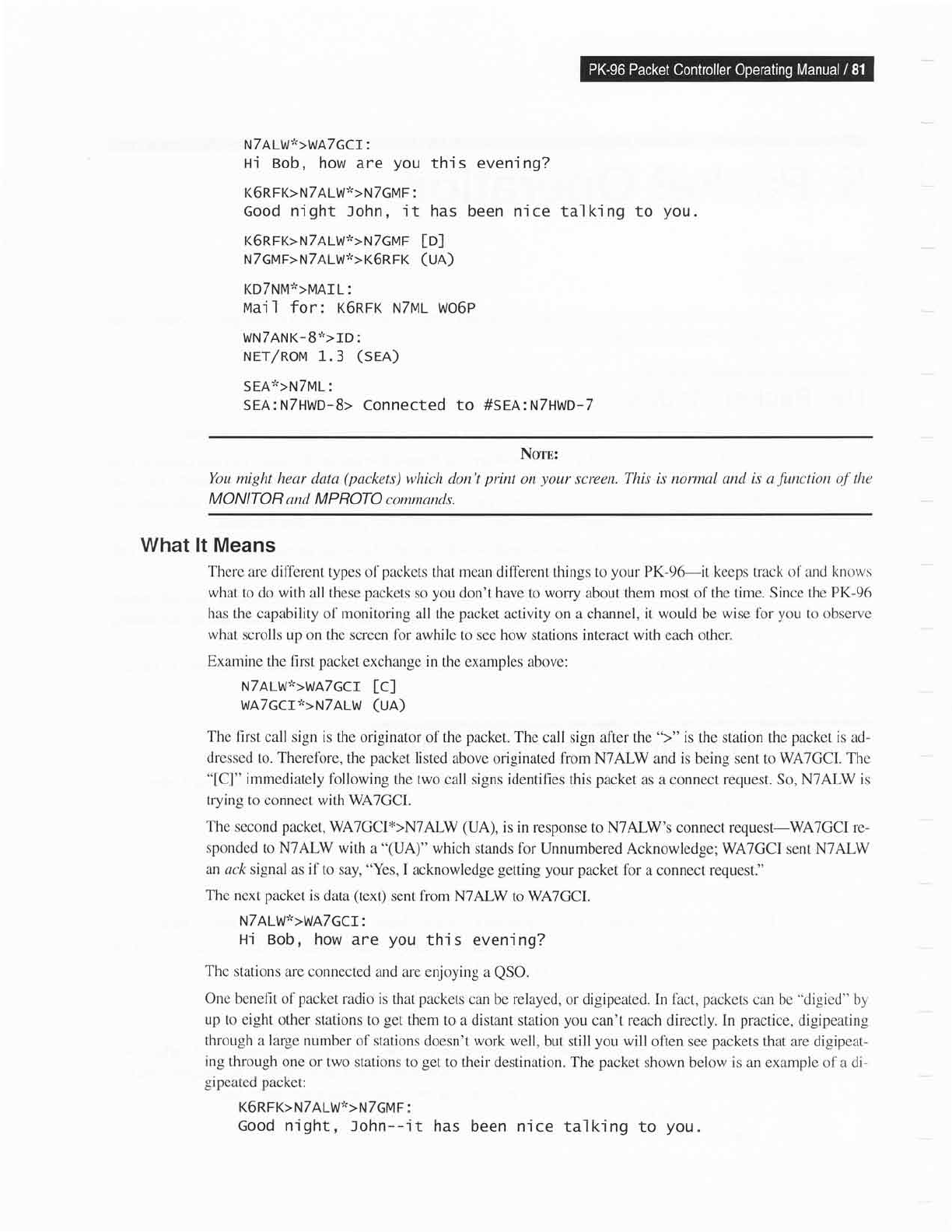Specifications
Table Of Contents

NTALWJ'>WATCCT:
Hi Bob,
how are
you
this evening?
K6RFK>N7ALW''>N7GMF:
cood n'ight :ohn, it has
been
n'ice
talking to
you.
K6RFGNTALW*>N7GMF
IO]
NTGMF>N7ALW">K6RFK
(UA)
KDTNMJ.>MAIL:
t\4ail for:
K6RFK NTML Wo6P
WNTANK-8J'>ID:
NEr/RoM 1_.3
(Sea)
SEAJ'>N7ML:
SEA:N7HWD-B> CONNECICd tO #SEA:N7HWD-7
NcnB:
You might hear data
(packets)
which don't
print
on
your
screen.
This
is normal and
is a
Junction
ofthe
MONITOR
and
MPROTO
commancls.
What lt Means
Thcrc are difl'erent
types ol'packets that
mean
difierent things to
your
PK-96-it kecps track ol'and
knows
what
to do
with
all these
packcts
so
you
don't have to worry
about
them most of the time. Since the
PK-96
has the capability
ol'monitoring all the
packet
activity on a channel, it would be
wise fbr
you
to
observc
what scrolls
up on the screen fbr awhile to see how stations interact with
each other.
Examine the first
packet
exchange in the examples above:
NTALWj.>WATGCr
tcl
WATGCIJ'>N7ALW
(UA)
The lirst
call sign is the originator
of the
packet.
The call sign after the
'}"
is the station the
packet
is ad-
dressed
to.
Therefbre,
the
packet
listed
abovc originated from NTALW and is being sent to WATGCI. Thc
"[C]"
immediately
fbllowing the
two call signs identifies this
packet
as a connect request. So, NTALW
is
trying to connect
with WATGCI.
The
second
packet,
WATGCI'I'>N7ALW
(UA),
is in response
to NTALW's connect request-WATGCI
re-
sponded
to NTALW
with a'{UA)" which
stands for Unnumbered Acknowledge; WATGCI
sent
NTALW
an
ack signal as if
to say,
"Yes,
I acknowledge
getting
your packet
for a connect request."
The next
packet
is
data
(text)
sent from
NTALW to WATGCI.
NTALW'">WATGCII
Hi Bob,
how are
you
this
evening?
The stations
are connected
and are enjoying a
QSO.
One
benefit ofpacket radio is
that
packets
can be relayed,
or digipeated.
In fact, packets
can bc
"digied"
by
up
to eight other stations
to
get
them to a distant station
you
can't reach directly. In
practice,
digipeating
through
a large number
of stations doesn't work well,
but still
you will
often see
packets
that are digipear
ing through
one or two stations
to
get
to their
destination.
The
packet
shown below is an example o[ a di-
gipeated
packet:
K6RFK>NTALW*>N7GMF:
cood
night,
:ohn--it has
been nice talk'ing
to
you.










